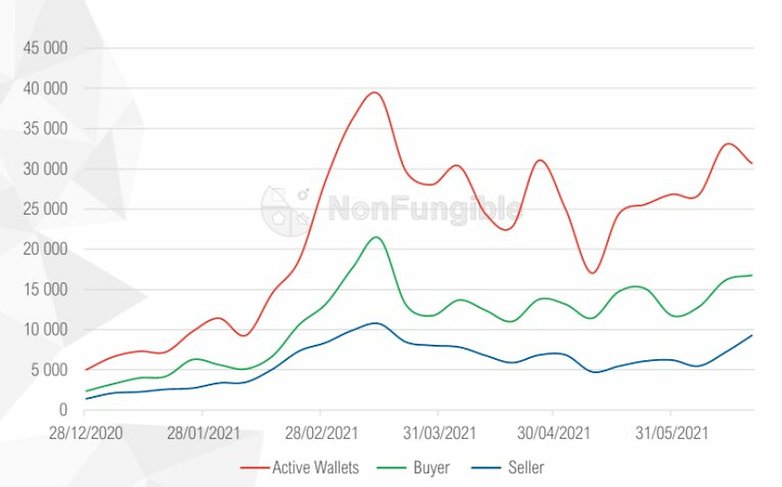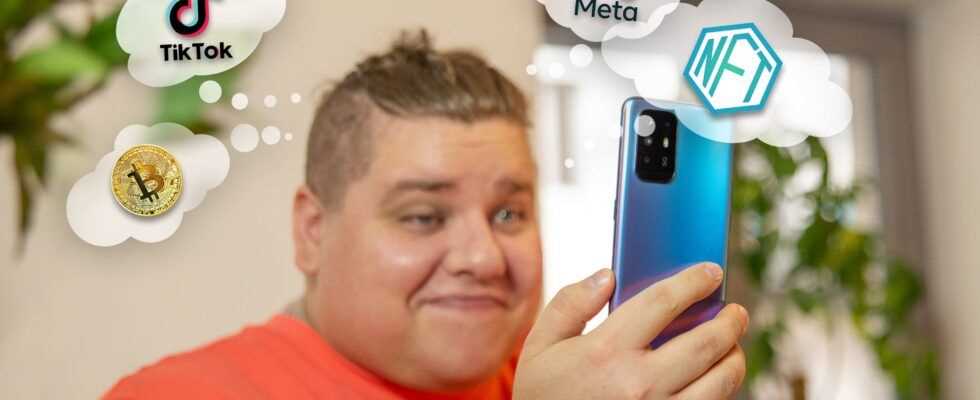“If by the age of 50 you don’t have a $ 10,000 JPEG in your wallet, you’ve achieved nothing in life.” Do you feel overwhelmed by the latest tech trends? Don’t worry, jump on the hype train with me, which arrives three years too late because I drive it myself!
In this post, I’m not going to pretend to be a teacher or pretend that I can educate you about NFT or Bitcoin after doing some Google research. But I’ll try to explain to you why I take a deep breath * TikTok with certain phenomena like NFTs, cryptocurrencies, Metaverse and … Yes, TikTok. TIK … TOK !!! … try to stay on the ball.
We are approaching the end of the year. I’m in my late 20s again and have to admit that I can’t do anything with Dogecoin and “non-fungible tokens”. In fact, I’m a little ashamed to admit it. After all, I’m a tech journalist and should be absolutely omniscient about anything tech-related, shouldn’t I?
But instead, I feel like I’m getting left behind more and more. That I am missing out on an entire socio-cultural layer and its possibilities and closing myself in my very smartphone and hardware-oriented niche. In short, I feel a little bit like I’m becoming a boomer.
My colleague Ben sometimes looks pretty old. / © NextPit
Prejudice: NFTs, Krypto and TikTok are hype culture as it is in the book
What do I mean by this umpteenth stupid Anglicism? For me, hype culture means artificially increasing the value of a product or service by associating it with emotions rather than more tangible elements like manufacturing quality.
By addressing emotions, especially the fear of missing out on something or not being up to date (FOMO, “fear of missing out”), the demand for the product or service that is supposed to overcome this fear is increased. In addition, there is a rarity effect due to limited editions and the creation of codes, jokes and memes that only the initiated can understand. Zack, the hyped product is ready.
This phenomenon is neither ultra-new nor exclusive to the tech industry or the ICT market. Take Nike, for example, who deliberately sell their sneakers in limited quantities and by lottery, in order to then resell them on StockX for ten times as much. This is the same principle as Clubhouse, which played out with their system of limited invitations as Privacy 3.0.
The last and for me the most striking example is Carl Pei, who sees himself as Anthony Hopkins in Westworld and philosophizes about ambient computing. Only to then bring out true wireless headphones with the Nothing Ear (1), which are high quality but not really special. I beat you down with these explanatory paragraphs to illustrate my vision of NFTs, crypto and all that “zoomer stuff”.
- A tutorial on what NFTs are from Wall Street Journal (English):
About bubbles that are about to burst
For example, I thought that most of the cryptocurrencies other than Bitcoin or Ethereum were just pyramid schemes just waiting to collapse. And that it was only kept up by a hype, with the new shoppers’ hype only driving up the value of the wallets of those who bought before them – and nothing else.
The same is true of NFTs, those virtual “objects” of ownership that, in my layman’s eyes, were just to show how rich you are. After all, you pay millions for a PNG that anyone could copy or download for free. In English one speaks of “fuck you money” when one has so much money that one could literally give a shit on anyone. But to me it was like paying to have a star named after me. In other words, I thought it was totally stupid.
And what about TikTok? Its algorithm is designed to make you feel like a celebrity, even with an average number of video views. These are completely disproportionate compared to what happens on YouTube, for example. Or Facebook, which has become a meta and believes it has reinvented the wheel. The existence of Second Life or VR Chat confirms that Meta is already too late here too.
In a nutshell: a lot of hype, but not much concrete. I just looked at these trends as memes. A fad that a group of early adopters and their followers cultivate to increase their sense of belonging and to attract newbies aka potential buyers by mistakenly inflating the value of their assets.

In Q2 2021 there were more sellers than buyers of NFT. / © NonFungible.com
What I learned from my role as a “Devils Advocate”
We get to the heart of this article – the part where I forcibly break away from my lazy prejudices and try to understand not these new concepts themselves, but their meaning. Because when you’re dealing with something so exclusive that only a handful of connoisseurs really understand, you don’t necessarily feel like taking part.
But in the end, I think to myself that the hype is not inherently good or bad. It depends much more on what you make of it. Take cryptocurrencies, for example. Yes, the market has spawned a multitude of alternative cryptos. Most of them have turned out to be frauds, or at least pure speculative bubbles, created to get rich at the expense of others. Therefore, the word “Shitcoin” circulates on the Internet for those currencies that are botch.
With Dogecoin, however, it is different. A cryptocurrency that grew out of a simple joke and became a worldwide meme. It has led to the fact that laypeople and above all “normal” people are interested in crypto as a cultural and not just a financial product.
You now see people engaging in financial markets as a form of consumption for entertainment and community as well as investing itself. And these “cultural assets” are inevitably much more volatile because they depend on the community they belong to Sustains life. As long as the joke is still funny.
But in an economy that is becoming more and more digital and open, jokes set the markets in motion. The story about GameStop shares in the USA made this very clear to us. Although the success was short-lived.
- The GameStop affair in 5 minutes from the BBC:
Into the NFTaverse
And what better way to illustrate the cultural dimension of new digital assets than with NFTs? Again, one might be alarmed by the volatility of the market, the mismatch between buyers and sellers, and the rise in prices. The latter even got some NFT creators to run away with their crypto package. And one can also marvel at the absurdity of the concept of owning a non-material good. After all, anyone could reproduce it practically identically, even if you’re the only one who owns the original.
But I think to myself that reintroducing some kind of property right to digital cultural goods in the age of dematerialization is not such a bad idea. In the last few years we have lost a lot of influence over games or music that we buy and that we cannot even freely dispose of. I would love to buy part of a video game that impressed me before it is no longer marketed and the manufacturer takes it out of stores. (A very interesting video on the same topic about the game Driver: San Francisco).
Of course you can’t be naive. It is no coincidence that Ubisoft, as one of the most profitable video game publishers and developers in the world, has become one of the leading providers of video games in recent years. And as one of the greediest companies in the industry, it got into blockchain gaming (French link) with NFTs in connection with in-game elements. But imagine if a developer would take this madness a little further. For example, you could buy a character that is unique in the game and develop that character further in the game and unlock upgrades. A scalable NFT that really serves a purpose.
It’s more interesting than buying vinyl, sneakers or even collectible figurines that you never take out of the box and that gather dust in your closet. The game “Blankos Block Party” from Mythical Games, unveiled at E3 2021, is one of the first attempts at doing just that, and I find the concept fascinating.
- The presentation video for the game Blankos Block Party (English):
And all of this makes even more sense when viewed in the context of a “metaverse”. The value of a good or its usefulness are usually corollaries. However, depending on how we perceive them, the gap between the two can be more or less great. An umbrella has the same use, regardless of whether it is pouring rain or you live in the middle of the desert. However, it does not have the same value.
The same goes for NFTs. Unless you are into social networking or video games in general, and your social interactions are mostly physical, owning a virtual item is of little concern. But if you depend a large part of your time in a virtual world and have established relationships with people there, the whole thing becomes more relevant.
If you’ve been addicted to a multiplayer game that offers in-app purchases, you know what I’m talking about. Except that you can have your skin and equipment here inside and outside the game. Personally, I see this as a mix of Counter Strike Go skins and Pokémon cards.
The Metaverse won’t reinvent anything that didn’t exist in the Second Life era or what is currently in VR chat. It’s about finding new ways to experience the same things. One cannot reinvent the concept of talking to people / meeting people, enjoying art together, creating fiction, appreciating art or buying things. These are behaviors that we’ve always had. But it’s about finding new ways, new media, to try them out.
- This German “Techtoker” is not reinventing the testing of smartphones, but has reconciled me a little with TikTok:
Conclusion
You don’t have to be a crypto broker. You don’t have to become a billionaire by selling PNG files, either. And you certainly don’t have to let a 28-year-old snot like me explain life to you.
This long article is not intended to make you change your mind about anything. It is just an invitation to broaden OUR horizons. Not to enlighten you with my wisdom, but to make you curious or even to become less ignorant yourself, for example through your comments under this article.
Whether in the “technosphere” or in any other niche: the goal is to discuss things and above all new To discuss things. It is good? Is it bad? Is it really new compared to what was done before? It’s true: the more time goes by, the less willing we are to fill our brains with new information to process. In 2021, the available brain time is literally money.
But I think if I stopped making this investment, this investment in my free time, I would be left by the wayside in the long run. At least that’s my fear. And maybe it’s FOMO again speaking out of me. But I’ve philosophized enough for today.
